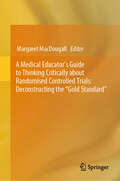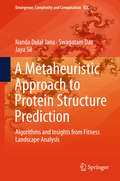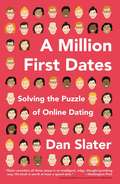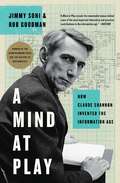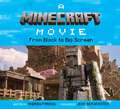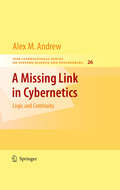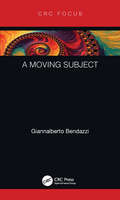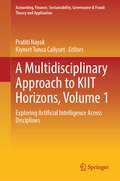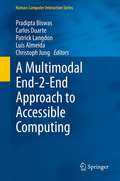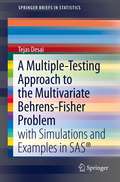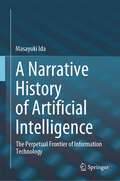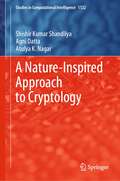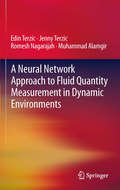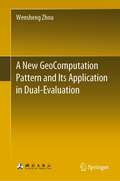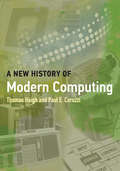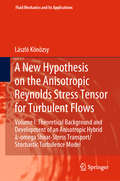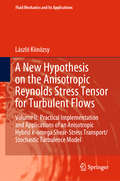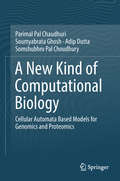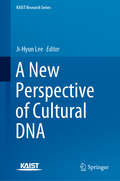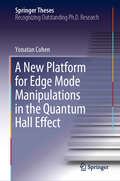- Table View
- List View
A Medical Educator's Guide to Thinking Critically about Randomised Controlled Trials: Deconstructing the "Gold Standard"
by Margaret MacDougallDrawing on the statistical and philosophical expertise of its authors, this book is designed to improve understanding and use of randomised controlled trials (RCTs) among health professionals. It is intended for use primarily by medical educators involved in teaching statistics and evidence-based medicine (EBM) to medical students, junior doctors and other health professionals. However, each of the chapters serves a wider range of interests, including the practical needs of physicians in interpreting research evidence to support clinical decision making and the teaching needs of philosophers of medicine who want to more fully appreciate how RCTs work in practice and provide engaging examples for their students. Rather than compete with the proliferating methodological literature on RCT designs, this book focuses on cultivating a healthy skepticism among developing health professionals to support critical appraisal of their own and published work on RCTs at a fundamental level, including through a more informed understanding of the place of subgroup analyses in sound statistical inference. Management of the positive predictive value in the statistical analysis of RCT findings is included as an important topic for contemporary medical curricula. In comparing RCTs with non-randomised studies, a search for empirical evidence for the superiority of RCTs is initiated, pointing to the need for further work to confirm what form this evidence should take.Medical educators will find a wealth of reasons to encourage their students to think more critically about how the RCT operates in practice as a gold standard.
A Metaheuristic Approach to Protein Structure Prediction: Algorithms And Insights From Fitness Landscape Analysis (Emergence, Complexity And Computation Ser. #31)
by Swagatam Das Nanda Dulal Jana Jaya SilThis book introduces characteristic features of the protein structure prediction (PSP) problem. It focuses on systematic selection and improvement of the most appropriate metaheuristic algorithm to solve the problem based on a fitness landscape analysis, rather than on the nature of the problem, which was the focus of methodologies in the past. Protein structure prediction is concerned with the question of how to determine the three-dimensional structure of a protein from its primary sequence. Recently a number of successful metaheuristic algorithms have been developed to determine the native structure, which plays an important role in medicine, drug design, and disease prediction. This interdisciplinary book consolidates the concepts most relevant to protein structure prediction (PSP) through global non-convex optimization. It is intended for graduate students from fields such as computer science, engineering, bioinformatics and as a reference for researchers and practitioners.
A Million First Dates
by Dan Slater** Previously published in hardcover as Love in the Time of Algorithms ** Once considered the realm of the lonely and desperate, sites like eHarmony, Match, OkCupid, and Plenty of Fish have been embraced by pretty much every demographic. Dating has been transformed from a daunting transaction based on scarcity to one in which the possibilities are almost endless. Now anyone can search for exactly what they want, connect with more people, and get more information about those people than ever before. As journalist Dan Slater shows, online dating is changing society in more profound ways than we imagine. He explores how these new technologies, by altering our perception of what's possible, are reconditioning our feelings about commitment and challenging the traditional paradigm of adult life. Slater takes readers behind the scenes of a fascinating business. Dating sites capitalize on our quest for love, but how do their creators' ideas about pro ts, morality, and the nature of desire shape the virtual worlds they've created for us?
A Mind at Play: How Claude Shannon Invented the Information Age
by Jimmy Soni Rob GoodmanWinner of the Neumann Prize for the History of Mathematics "We owe Claude Shannon a lot, and Soni & Goodman&’s book takes a big first step in paying that debt." —San Francisco Review of Books "Soni and Goodman are at their best when they invoke the wonder an idea can instill. They summon the right level of awe while stopping short of hyperbole." —Financial Times "Jimmy Soni and Rob Goodman make a convincing case for their subtitle while reminding us that Shannon never made this claim himself." —The Wall Street Journal &“A charming account of one of the twentieth century&’s most distinguished scientists…Readers will enjoy this portrait of a modern-day Da Vinci.&” —FortuneIn their second collaboration, biographers Jimmy Soni and Rob Goodman present the story of Claude Shannon—one of the foremost intellects of the twentieth century and the architect of the Information Age, whose insights stand behind every computer built, email sent, video streamed, and webpage loaded. Claude Shannon was a groundbreaking polymath, a brilliant tinkerer, and a digital pioneer. He constructed the first wearable computer, outfoxed Vegas casinos, and built juggling robots. He also wrote the seminal text of the digital revolution, which has been called &“the Magna Carta of the Information Age.&” In this elegantly written, exhaustively researched biography, Soni and Goodman reveal Claude Shannon&’s full story for the first time. With unique access to Shannon&’s family and friends, A Mind at Play brings this singular innovator and always playful genius to life.
A Minecraft Movie: From Block to Big Screen
by Andrew FaragoGo behind the scenes of A Minecraft Movie and experience the creative journey that transformed the biggest video game of all time into a big-screen block-buster.Break open the filmmaking secrets of A Minecraft Movie with this deluxe art book. Featuring commentary from the filmmakers, this volume explores how a team of world-class artists brought the iconic, limitless world of Minecraft to the big screen. Including insights from the creatives as well as stunning illustrations and visuals––such as never-before-seen concept art and photography––this book is the ultimate companion to the first ever live-action adaptation of Minecraft. NEVER-BEFORE-SEEN IMAGERY: From character, mob, and item designs to images of in-world Minecraft locations and stunning photography, this book offers an incredible gallery of visuals from A Minecraft Movie. INTERVIEWS WITH CREATORS: Immerse yourself in the world of Minecraft like never before with exclusive behind the scene insights from the game creators and filmmakers. MINE THE CREATIVE CRAFT: Follow the filmmaking process of adapting the biggest video game of all time via beautiful concept art, amazing photography, and more.
A Missing Link in Cybernetics: Logic and Continuity (IFSR International Series in Systems Science and Systems Engineering #26)
by Alex M. AndrewThe text begins by reviewing the origins and aims of cybernetics with particular reference to Warren McCulloch's declared lifetime quest of "understanding man's understanding". It is shown that continuous systems can undergo complex self-organization, but a need for classification of situations becomes apparent and can be seen as the evolutionary beginning of concept-based processing. Possibilities for complex self-organization are emphasized by discussion of a general principle that has been termed significance feedback, of which backpropagation of errors in neural nets is a special case. It is also noted that continuous measures come to be associated with processing that is essentially concept-based, as acknowledged in Marvin Minsky's reference to heuristic connection between problems, and the associated basic learning heuristic of Minsky and Selfridge. This reappearance of continuity, along with observations on the multi-layer structure of intelligent systems, supports a potentially valuable view of intelligence as having a fractal nature. This is such that structures at a complex level, interpreted in terms of these emergent measures, reflect others at a simpler level. Implications for neuroscience and Artificial Intelligence are also examined. The book presents unconventional and challenging viewpoints that will be of interest to researchers in AI, psychology, cybernetics and systems science, and should help promote further research.
A Moving Subject
by Giannalberto BendazziDescription: A Moving Subject offers a collection of essays from around the world. From Italy to the Middle East, from an analysis of A Night on Bald Mountain to African cinema animation, these essays help to paint the world of animation in a comprehensive and international manner. Handpicked by renowned animation historian and researcher Giannalberto Bendazzi, this book offers a look at the global foundations of animation from disparate regions, peoples and methods, and helps to demonstrate animation as a unifying factor of the human race. Key Features: A fresh perspective on animation from a global lens A new look into traditional animation produced from around the world Essays that reflect on the nature of colour, animation and light Author: A former professor at the Nanyang Technological University of Singapore and the Università degli Studi of Milan, Italian-born Giannalberto Bendazzi has thoroughly investigated the history of animation for more than forty years. A founding member of the Society for Animation Studies, he has authored or edited various classics in various languages and has lectured extensively on every continent. He received an honorary doctorate from Lisbon University in 2019.
A Multidisciplinary Approach to KIIT Horizons, Volume 1: Exploring Artificial Intelligence Across Disciplines (Accounting, Finance, Sustainability, Governance & Fraud: Theory and Application)
by Kıymet Tunca Çalıyurt Pratiti NayakThis book explores the effects of Artificial Intelligence (AI) across different disciplines. As AI applications continue to progress, serious concerns arise about effectively protecting the copyright of items they produce. Each country views AI as an author while maintaining rights differently, resulting in the compelling necessity for an international dialogue on legal standards. The present copyright framework does not provide sufficient solutions for AI authorship intricacies and raises doubts about classic notions of invention and source. The distinctions show an increasing demand for a global legal system that can address the unique characteristics of AI-generated content. Investigating legal policies for AI-created works underscores the critical demand for a copyright approach that accounts for human involvement. Recognizing the actual owner and the original creator is complicated when AI operates with substantial control. Present statutes fail to clarify the complexities linked to human artistic contributions. The rationale behind developing a single system is based on valuing AI-produced material as a unique category of intellectual property. As AI becomes more significant in creative fields, legal dialogues must also be similarly enhanced. The approaches considered in the book strive to build improved regulations that represent the progress in AI technology and the basic concepts of copyright. The book goes on to propose a consistent policy model to confront AI obstacles related to intellectual property and would be a valuable read for policy makers and AI enthusiasts alike.
A Multidisciplinary Introduction to Information Security (Discrete Mathematics and Its Applications)
by Stig F. MjølsnesWith most services and products now being offered through digital communications, new challenges have emerged for information security specialists. A Multidisciplinary Introduction to Information Security presents a range of topics on the security, privacy, and safety of information and communication technology. It brings together methods in pure m
A Multimodal End-2-End Approach to Accessible Computing (Human–Computer Interaction Series)
by Pradipta Biswas Patrick Langdon Luis Almeida Carlos DuarteThis book illustrates how Interactive Systems can help elderly and disabled populations engage with the world around them by finding methods of overcoming the difficulties these communities face when using such systems by presenting the latest in state-of-the-art technology and providing a vision for accessibility for the near future. The challenges faced by accessibility practitioners are discussed and the different phases of delivering accessible products and services are explored. A collection of eminent researchers from around the world cover topics on developing and standardizing user models for inclusive design, adaptable multimodal system development for digital TV and ubiquitous devices, presenting research on intelligent voice recognition, adaptable pointing, browsing and navigation, and affect and gesture recognition. The research not only focuses on how these can be hugely beneficial to primary users, but often finding useful applications for their able-bodied counterparts. For this new edition, new chapters have been added focusing on the latest developments in games for the visually impaired, inclusive interfaces for the agricultural industry in India and technologies to improve accessibility in broadcasting in Japan. A Multimodal End-2-End Approach to Accessible Computing will be an invaluable resource for both researchers and practitioners alike.
A Multimodal End-2-End Approach to Accessible Computing (Human–Computer Interaction Series)
by Pradipta Biswas, Carlos Duarte, Patrick Langdon, Luis Almeida and Christoph JungResearch in intelligent interactive systems can offer valuable assistance to elderly and disabled populations by helping them to achieve greater levels of engagement with the world. Many users find it difficult to use existing interaction devices, either for physical or age-related impairments. However, research on intelligent voice recognition, adaptable pointing, browsing and navigation, and affect and gesture recognition can hugely benefit such users. Additionally, systems and services developed for elderly or disabled people often find useful applications for their able-bodied counterparts.A Multimodal End-2-End Approach to Accessible Computing illustrates the state-of-the-art of technology and presents a vision for accessibility in the near future. It considers challenges faced by accessibility practitioners at research institutes, industries and legislative institutions throughout the world, and explores the different phases of delivering accessible products and services through design, development, deployment and maintenance. A collection of eminent researchers cover topics on developing and standardizing user models for inclusive design, adaptable multimodal system development for digital TV and ubiquitous devices.With a foreword from the BBC’s Head of Technology and organiser of the Switchover Help Scheme, and an End Note from the chairman of the ITU-T’s Focus Group on Audiovisual Media Accessibility (presenting a vision for accessible computing), this book will be an invaluable resource for researchers and practitioners.
A Multiple-Testing Approach to the Multivariate Behrens-Fisher Problem: with Simulations and Examples in SAS® (SpringerBriefs in Statistics)
by Tejas DesaiIn statistics, the Behrens-Fisher problem is the problem of interval estimation and hypothesis testing concerning the difference between the means of two normally distributed populations when the variances of the two populations are not assumed to be equal, based on two independent samples. In his 1935 paper, Fisher outlined an approach to the Behrens-Fisher problem. Since high-speed computers were not available in Fisher's time, this approach was not implementable and was soon forgotten. Fortunately, now that high-speed computers are available, this approach can easily be implemented using just a desktop or a laptop computer. Furthermore, Fisher's approach was proposed for univariate samples. But this approach can also be generalized to the multivariate case. In this monograph, we present the solution to the afore-mentioned multivariate generalization of the Behrens-Fisher problem. We start out by presenting a test of multivariate normality, proceed to test(s) of equality of covariance matrices, and end with our solution to the multivariate Behrens-Fisher problem. All methods proposed in this monograph will be include both the randomly-incomplete-data case as well as the complete-data case. Moreover, all methods considered in this monograph will be tested using both simulations and examples.
A Narrative History of Artificial Intelligence: The Perpetual Frontier of Information Technology
by Masayuki IdaThis book addresses the history of artificial intelligence through the author’s experiences from the 1960s, when AI was a dream to give computers far more power than the progress for industrial technological advancement. The book starts from the AI pioneering days including what the author witnessed and impressed, then the episodes during AI boom of the 80s and 90s when the author was involved in ANSI X3J13 committee work as a principal member, translating Common Lisp books into Japanese, leading committee works in Japan for global standardization, and visiting MIT AI Lab for totally three years. The book points out that neural network research started in the 1980s, highlighting the DARPA report dated in 1988. The last episodes and thoughts include the experiences with business school students after the author moved from engineering school. The former half is from a view of an engineering mind and then the latter is based on how the author struggled with business-minded people to explain the core of AI. This book is suitable for anyone interested in the history of Artificial Intelligence. The content is easy to follow, even for readers without prior knowledge of AI. Experts will also find something new and thought-provoking.
A Nature-Inspired Approach to Cryptology (Studies in Computational Intelligence #1122)
by Atulya K. Nagar Shishir Kumar Shandilya Agni DattaThis book introduces nature-inspired algorithms and their applications to modern cryptography. It helps the readers to get into the field of nature-based approaches to solve complex cryptographic issues. This book provides a comprehensive view of nature-inspired research which could be applied in cryptography to strengthen security. It will also explore the novel research directives such as Clever algorithms and immune-based cyber resilience. New experimented nature-inspired approaches are having enough potential to make a huge impact in the field of cryptanalysis. This book gives a lucid introduction to this exciting new field and will promote further research in this domain. The book discusses the current landscape of cryptography and nature-inspired research and will be helpful to prospective students and professionals to explore further.
A Networked Self: Identity, Community, and Culture on Social Network Sites
by Zizi PapacharissiA Networked Self examines self presentation and social connection in the digital age. This collection brings together new work on online social networks by leading scholars from a variety of disciplines. The focus of the volume rests on the construction of the self, and what happens to self-identity when it is presented through networks of social connections in new media environments. The volume is structured around the core themes of identity, community, and culture - the central themes of social network sites. Contributors address theory, research, and practical implications of many aspects of online social networks including self-presentation, behavioral norms, patterns and routines, social impact, privacy, class/gender/race divides, taste cultures online, uses of social networking sites within organizations, activism, civic engagement and political impact.
A Networked Self: Identity, Community, and Culture on Social Network Sites (A Networked Self)
by Zizi PapacharissiA Networked Self examines self presentation and social connection in the digital age. This collection brings together new work on online social networks by leading scholars from a variety of disciplines. The focus of the volume rests on the construction of the self, and what happens to self-identity when it is presented through networks of social connections in new media environments. The volume is structured around the core themes of identity, community, and culture - the central themes of social network sites. Contributors address theory, research, and practical implications of many aspects of online social networks including self-presentation, behavioral norms, patterns and routines, social impact, privacy, class/gender/race divides, taste cultures online, uses of social networking sites within organizations, activism, civic engagement and political impact.
A Neural Network Approach to Fluid Quantity Measurement in Dynamic Environments
by Edin Terzic Romesh Nagarajah Muhammad Alamgir Jenny TerzicSloshing causes liquid to fluctuate, making accurate level readings difficult to obtain in dynamic environments. The measurement system described uses a single-tube capacitive sensor to obtain an instantaneous level reading of the fluid surface, thereby accurately determining the fluid quantity in the presence of slosh. A neural network based classification technique has been applied to predict the actual quantity of the fluid contained in a tank under sloshing conditions. In A neural network approach to fluid quantity measurement in dynamic environments, effects of temperature variations and contamination on the capacitive sensor are discussed, and the authors propose that these effects can also be eliminated with the proposed neural network based classification system. To examine the performance of the classification system, many field trials were carried out on a running vehicle at various tank volume levels that range from 5 L to 50 L. The effectiveness of signal enhancement on the neural network based signal classification system is also investigated. Results obtained from the investigation are compared with traditionally used statistical averaging methods, and proves that the neural network based measurement system can produce highly accurate fluid quantity measurements in a dynamic environment. Although in this case a capacitive sensor was used to demonstrate measurement system this methodology is valid for all types of electronic sensors. The approach demonstrated in A neural network approach to fluid quantity measurement in dynamic environments can be applied to a wide range of fluid quantity measurement applications in the automotive, naval and aviation industries to produce accurate fluid level readings. Students, lecturers, and experts will find the description of current research about accurate fluid level measurement in dynamic environments using neural network approach useful.
A New GeoComputation Pattern and Its Application in Dual-Evaluation
by Wensheng ZhouThis book introduces Document As System (DAS), a new GeoComputation pattern, which is also a new GIS application pattern. It uses the GeoComputation language (G language) to describe and execute complex spatial analysis model in the MS Word environment, which solves the bottleneck problem of GIS application, makes GIS become a popular tool for spatial data analysis from the spatial data visualization tool, and plays an important role in the wide application of GIS technology. This book systematically introduces the theory related to the new GeoComputation pattern and the application example in the “dual-evaluation” of territorial and spatial planning, which can be used as a learning and reference manual for GIS related professionals and business personnel engaged in the “dual-evaluation” of territorial and spatial planning.
A New History of Modern Computing (History of Computing)
by Paul E. Ceruzzi Thomas HaighHow the computer became universal.Over the past fifty years, the computer has been transformed from a hulking scientific supertool and data processing workhorse, remote from the experiences of ordinary people, to a diverse family of devices that billions rely on to play games, shop, stream music and movies, communicate, and count their steps. In A New History of Modern Computing, Thomas Haigh and Paul Ceruzzi trace these changes. A comprehensive reimagining of Ceruzzi's A History of Modern Computing, this new volume uses each chapter to recount one such transformation, describing how a particular community of users and producers remade the computer into something new. Haigh and Ceruzzi ground their accounts of these computing revolutions in the longer and deeper history of computing technology. They begin with the story of the 1945 ENIAC computer, which introduced the vocabulary of "programs" and "programming," and proceed through email, pocket calculators, personal computers, the World Wide Web, videogames, smart phones, and our current world of computers everywhere--in phones, cars, appliances, watches, and more. Finally, they consider the Tesla Model S as an object that simultaneously embodies many strands of computing.
A New Hypothesis on the Anisotropic Reynolds Stress Tensor for Turbulent Flows: Volume I: Theoretical Background and Development of an Anisotropic Hybrid k-omega Shear-Stress Transport/Stochastic Turbulence Model (Fluid Mechanics and Its Applications #120)
by László KönözsyThis book gives a mathematical insight--including intermediate derivation steps--into engineering physics and turbulence modeling related to an anisotropic modification to the Boussinesq hypothesis (deformation theory) coupled with the similarity theory of velocity fluctuations. Through mathematical derivations and their explanations, the reader will be able to understand new theoretical concepts quickly, including how to put a new hypothesis on the anisotropic Reynolds stress tensor into engineering practice. The anisotropic modification to the eddy viscosity hypothesis is in the center of research interest, however, the unification of the deformation theory and the anisotropic similarity theory of turbulent velocity fluctuations is still missing from the literature. This book brings a mathematically challenging subject closer to graduate students and researchers who are developing the next generation of anisotropic turbulence models. Indispensable for graduate students, researchers and scientists in fluid mechanics and mechanical engineering.
A New Hypothesis on the Anisotropic Reynolds Stress Tensor for Turbulent Flows: Volume II: Practical Implementation and Applications of an Anisotropic Hybrid k-omega Shear-Stress Transport/Stochastic Turbulence Model (Fluid Mechanics and Its Applications #125)
by László KönözsyThis self-contained, interdisciplinary book encompasses mathematics, physics, computer programming, analytical solutions and numerical modelling, industrial computational fluid dynamics (CFD), academic benchmark problems and engineering applications in conjunction with the research field of anisotropic turbulence. It focuses on theoretical approaches, computational examples and numerical simulations to demonstrate the strength of a new hypothesis and anisotropic turbulence modelling approach for academic benchmark problems and industrially relevant engineering applications. This book contains MATLAB codes, and C programming language based User-Defined Function (UDF) codes which can be compiled in the ANSYS-FLUENT environment. The computer codes help to understand and use efficiently a new concept which can also be implemented in any other software packages. The simulation results are compared to classical analytical solutions and experimental data taken from the literature. A particular attention is paid to how to obtain accurate results within a reasonable computational time for wide range of benchmark problems. The provided examples and programming techniques help graduate and postgraduate students, engineers and researchers to further develop their technical skills and knowledge.
A New Kind of Computational Biology: Cellular Automata Based Models for Genomics and Proteomics
by Parimal Pal Chaudhuri Soumyabrata Ghosh Adip Dutta Somshubhro Pal ChoudhuryThis book reflects more than three decades of research on Cellular Automata (CA), and nearly a decade of work on the application of CA to model biological strings, which forms the foundation of 'A New Kind of Computational Biology' pioneered by the start-up, CARLBio. After a brief introduction on Cellular Automata (CA) theory and functional biology, it reports on the modeling of basic biological strings with CA, starting with the basic nucleotides leading to codon and anti-codon CA models. It derives a more involved CA model of DNA, RNA, the entire translation process for amino acid formation and the evolution of protein to its unique structure and function. In subsequent chapters the interaction of Proteins with other bio-molecules is also modeled. The only prior knowledge assumed necessary is an undergraduate knowledge of computer programming and biology. The book adopts a hands-on, “do-it-yourself” approach to enable readers to apply the method provided to derive the CA rules and comprehend how these are related to the physical ‘rules’ observed in biology. In a single framework, the authors have presented two branches of science – Computation and Biology. Instead of rigorous molecular dynamics modeling, which the authors describe as a Bottoms-Up model, or relying on the Top-Down new age Artificial Intelligence (AI) and Machine Language (ML) that depends on extensive availability of quality data, this book takes the best from both the Top-Down and Bottoms-up approaches and establishes how the behavior of complex molecules is represented in CA. The CA rules are derived from the basic knowledge of molecular interaction and construction observed in biological world but mapped to a few subset of known results to derive and predict results.This book is useful for students, researchers and industry practitioners who want to explore modeling and simulation of the physical world complex systems from a different perspective. It raises the inevitable the question – ‘Are life and the universe nothing but a collection of continuous systems processing information’.
A New Perspective of Cultural DNA (KAIST Research Series)
by Ji-Hyun LeeThis book presents selected papers from the 3rd Cultural DNA Workshop. Contributed by prominent computational design experts in the fields of mechanical engineering and architectural design, they mainly focus on the design process; shape grammars as a valuable tool; and the analysis of cultural values.The book offers readers fresh viewpoints on computational design. and helps researchers in academy and practitioners in industry to learn more evolved cultural DNA knowledge which is newly interpreted and conceptually reinforced in areas of mechanical engineering and architectural engineering.
A New Platform for Edge Mode Manipulations in the Quantum Hall Effect (Springer Theses)
by Yonatan CohenIn the last several decades, the quantum Hall effect has provided a remarkable platform for manipulating one-dimensional electronic modes and investigating fundamental physical phenomena. However, certain limitations make it difficult for various kinds of interesting modes structures to be formed using this platform. One example is the so called helical mode structure, in which two one-dimensional, counter propagating modes have opposite spins and thus spin and momentum are locked. Such helical modes have lately attracted significant interest, since, when coupled to a conventional superconductor, they are expected to manifest topological superconductivity and host Majorana zero modes. Even more interesting are fractional helical modes, which open the way for realizing generalized parafermionic zero modes. Possessing non-abelian exchange statistics, these quasiparticles may serve as building blocks in topological quantum computing. Here we present a new platform for manipulating integer and fractional quantum Hall edge modes, which allows the formation of robust one-dimensional helical as well as fractional helical modes. The platform is based on a carefully designed double-quantum-well structure in a GaAs based system hosting two electronic sub-bands in the quantum Hall effect regime. By electrostatic gating of different areas of the structure, counter-propagating integer, as well as fractional, edge modes with opposite spins are formed and their spin protection is verified. Beyond the formation of helical modes, the new platform can serve as a rich playground for new research. Some new possibilities include the artificial induction of compounded fractional edge modes and the construction of new edge mode-based interferometers.
A New Republic of Letters
by Jerome McgannA manifesto for the humanities in the digital age, A New Republic of Letters argues that the history of texts, together with the methods by which they are preserved and made available for interpretation, are the overriding subjects of humanist study in the twenty-first century. Theory and philosophy, which have grounded the humanities for decades, no longer suffice as an intellectual framework. Jerome McGann proposes we look instead to philology--a discipline which has been out of fashion for many decades but which models the concerns of digital humanities with surprising fidelity. For centuries, books have been the best way to preserve and transmit knowledge. But as libraries and museums digitize their archives and readers abandon paperbacks for tablet computers, digital media are replacing books as the repository of cultural memory. While both the mission of the humanities and its traditional modes of scholarship and critical study are the same, the digital environment is driving disciplines to work with new tools that require major, and often very difficult, institutional changes. Now more than ever, scholars need to recover the theory and method of philological investigation if the humanities are to meet their perennial commitments. Textual and editorial scholarship, often marginalized as a narrowly technical domain, should be made a priority of humanists' attention.
